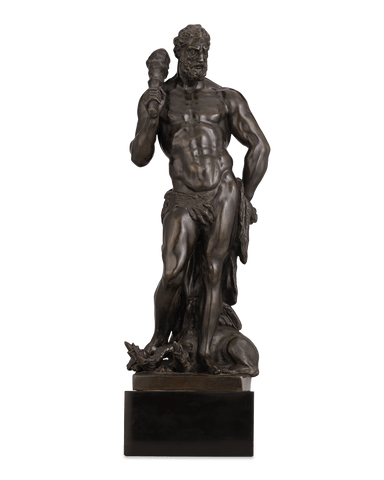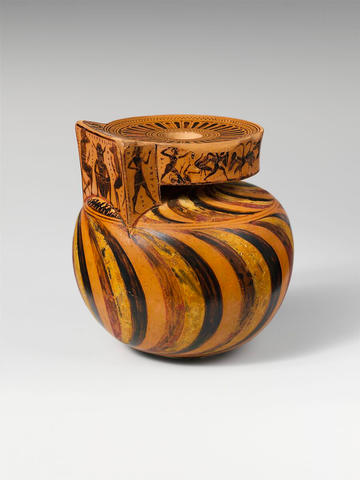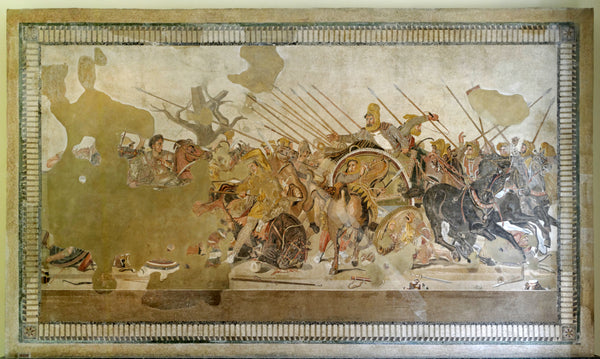Many of us attribute artistic greatness to the spectacular societies of the ancient Mediterranean world. The shining, white marble busts, free-standing Corinthian columns, and enormous temple pediments make it easy to be overwhelmed by the awe of Classical grandeur. But this aesthetic drama is imbued with something more— a sense of mysticism and significance keeps art lovers coming back, again and again, to reimagine, recreate, and revive the wonder of the Classics.
The History of Greco-Roman Art
The term “Classical” refers to the ancient Greek and Roman world, and is often used to describe a genre of artwork that was produced in Greco-Roman antiquity. In the mid-18th century, a new category known as "Neoclassical" arose, incorporating in its art the iconography, motifs and styles of the Classical period.
Types of Classical Art
SculptureSculpted figures, ceramics, mosaics and jewelry are four major types of artwork that comprise the artistic oeuvre of the Greeks and Romans. The earliest sculpted figures were created as part of the Archaic period, from around 650 to 480 BC. These figures were shown in rigid poses with limited facial expressions and unnatural proportions.
Over time, figural depictions became more naturalized as the study of the human body became more widely practiced. With the fascination of the human form came the idealization of the body, and by the later Classical and Hellenistic periods, from around 510 BC to 31 BC, Classical sculpture explored variation in musculature, age, behavior and abnormalities. The stylistic changes of these sculptures also catalyzed a shift from the use of marble to bronze. While marble could be delicately carved and painted, bronze offered what marble could not: durability, shine and the ability to be cast for highly detailed renderings of the human form.

Ceramics
High gloss and hand-crafted ceramics were a central element of Hellenic art as they served as both functional and aesthetic pieces. Vases, used to store wine, oil and other luxury goods, were often decorated with red and black figure paintings, a style common in many classical and neoclassical ceramics. To achieve this effect, the pottery was first painted with a glaze to create a pattern or image. In the initial firing stage, air was allowed into the kiln and the entire vase was turned the color of clay.
Next, oxygen was reintroduced to the kiln by inserting a piece of wood. As the wood burned and produced smoke, the vase turned black. Finally, more air was reintroduced to the kiln, causing the previously glazed areas to turn orange, while the rest of the oxidized piece stayed black. This process, both technologically advanced and extremely popular, gave ancient pottery the distinctive glossy finish and detailed imagery that is easily recognizable today.

Terracotta aryballos (oil flask)
Signed by Nearchos
circa 570 BCE. Metropolitan Museum of Art.
Mosaics
The ancient Roman city of Pompeii is said to be known for two reasons. The first is for its destruction by the infamous Mount Vesuvius in 79 AD, and the second for its breathtaking mosaics. Such mosaics were used as indoor or outdoor decoration and even flooring or tabletops. What is perhaps more intriguing about these crafts was the use of tesserae, small pieces of stone gathered from across the Mediterranean, to create an image or pattern.
The Alexander Mosaic, found at the House of the Faun in Pompeii, depicts Alexander the Great at the Battle of Gaugamela fighting King Darius II of Persia. Not only is this mosaic historically significant in its depiction of the legendary Persian War, but it also exemplifies the remarkable aesthetic beauty that the meticulous placement of colored tesserae could produce.

Alexander Mosaic | National Archaeological Museum, Naples, Italy.
Shining jewels and glistening gold made up the greatest pieces of Hellenistic and Roman jewelry. In the 8th century, as Greece expanded its trade network, its art and jewelry were influenced by the culture and resources of places like Persia and Macedonia. There was a broad market for earrings, necklaces, pendants, pins, bracelets, and armbands and many pieces were inlaid with precious stones.
How is Greco-Roman Art Viewed by the Art World Today?
What some may consider “old-fashioned” classical work is nonetheless some of the most coveted on the art market today. At auction houses around the world, ancient Hellenistic and Roman pieces are sold at increasingly high prices and their romantic nature is punctuated by a natural allure for buyers: it is exhilarating to own a piece crafted by a master artisan thousands of years ago.Because of their rarity, pieces from antiquity cannot be exactly reproduced, which makes their acquisition even more desirable. By owning something from the ancient world, a person is endowed with a physical object that serves as a portal to the past, stimulating their imagination and inspiring personal reflection on classical ideals.
Artistic Interpretation
Likewise, the long-established popularity of ancient pieces like Laocoon and His Sons or the Artemision Bronze have since inspired artists who seek to mimic the styles of the classical world in their work. Daniele Fortuna is one sculptor who blends contemporaneity with antiquity by incorporating pop culture and modern materials into his unconventional, yet fashionable recreations of classical sculptures.
In an interview with Deodato Art, he said:
“We usually think that if something is done in a certain way it cannot change, but you always have to look for a meeting point. Classical statues were not white, but colored. They were also made to represent a god or an athlete and they had their history. Then the passage of time changed them until they arrived to us partly destroyed, without some parts, and this is another side of history. I find it fascinating that the same sculpture has parallel stories, one dictated by the represented character and the other by what the statue itself experienced.”
Daniele uses inspiration from classical antiquity as well as from pop artists like Takashi Murakami, Yves Klein and Andy Warhol to create his unique and admirable artworks.

Many universities and museums aspire to integrate modernity with the antique. In a 2016 Exhibition at the Museum of Classical Archaeology at Cambridge titled “RECASTING”, curators placed 600 19th-century plaster casts of Classical sculptures next to the work of seven contemporary artists. They hoped to “trace how artmaking in the present is tied to the artmaking of thousands of years ago,” and in doing so, allowed artists to explore their relationship with classical art, even if it meant testing its cultural fortitude against changing social and artistic practices.
Greco-Roman is Here to Stay
From our ancient predecessors, the modern world received its initial knowledge of anatomy, proportions, balance and artistic technique. Like a tree branching in all directions, every subsequent art movement proved to reflect on and be guided by the ones that came before it, each stemming from a foundation of Greco-Roman roots. Today, we continue to see inspiration from the classics in everything from governmental architecture to contemporary abstract art.Some believe in the traditionally negative expression that those who do not learn history are doomed to repeat it. In many ways, this rings true for antiquity — forgetting the lessons of humanism, democracy and even early artistic practices would disrupt our modern civilization and cause us to make the same mistakes of those long ago. Art collectors, sellers and connoisseurs feel the imperative to study, preserve and exalt the works of the ancient world— there is still so much more to learn.






